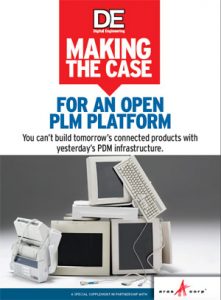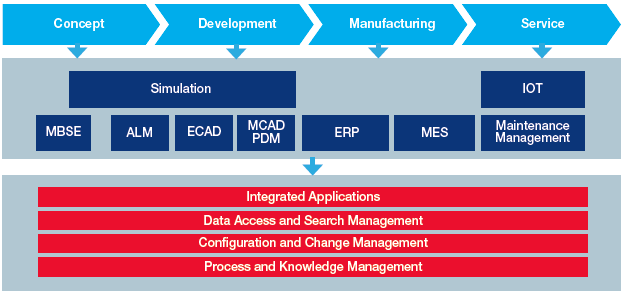Latest News
May 2, 2017
 Mounting product complexity necessitates sophisticated product development platforms to foster innovation and streamline collaboration. Yet, the reality is, most traditional product lifecycle management (PLM) and product data management (PDM) systems lack the capabilities to help engineering organizations meet their objectives and accelerate time to market.
Mounting product complexity necessitates sophisticated product development platforms to foster innovation and streamline collaboration. Yet, the reality is, most traditional product lifecycle management (PLM) and product data management (PDM) systems lack the capabilities to help engineering organizations meet their objectives and accelerate time to market.
The proliferation of sensors and software, driven by demand for smart, connected products and the Internet of Things (IoT), has raised the stakes for manufacturers. Purely mechanical designs are becoming rare, as manufacturers now need to incorporate electronics and software, as well as integrate products into system designs, or into systems of systems. In addition to product complexity, manufacturers face heightened global competition, both from their traditional ranks and from new tech-savvy disruptors, which have the potential to undermine their businesses. At the same time, increased activity on the regulatory front has put pressure on manufacturers to maintain visibility on product configuration throughout the entire lifecycle.
Legacy PLM and PDM applications and related processes were designed for a simpler era and are being stretched by current-day product development processes and requirements. These systems are not adequately equipped to coordinate global collaboration among engineers in different disciplines spanning mechanical, software and electrical/electronics. They also lack capabilities for managing configurations and facilitating processes that span the entire product lifecycle, especially field maintenance and support, which is an increasingly important element of smart, connected products. The ability to collect data from products—for example, monitoring of aero engines to facilitate predictive maintenance services—or deliver key capabilities through in-service software updates is becoming a prerequisite for next-generation products.
The growing reliance on partners and suppliers for the design of critical product components also tests the capacity of existing PDM and PLM systems. Here again, existing PDM and PLM systems are often hamstrung with closed proprietary architectures and limited capacity for integration with other enterprise systems, not to mention high costs due to their traditional licensing paradigms.
Fragmented IT Architectures Require an Open PLM Platform
Existing PDM systems have largely remained focused on 3D computer-aided design (CAD) data management, aiding in some of the more technical documentation and workflow aspects of engineering, but not making the leap to address broader business-related concerns. This has resulted in disconnected processes. The full vision of PLM has also struggled to get off the ground. Traditional PLM typically requires complex customizations that prevent systems from being easily upgraded, and the heavily customized data models and workflows make it extremely difficult to implement user-driven changes. For the same reasons, it becomes hard to keep the PLM system current with continually shifting market and user requirements, or to implement ongoing vendor upgrades and enhancements.
These limitations have affected the perceived benefits of PLM, which has been criticized for taking too long to implement, being almost impossible to upgrade and too narrowly focused. Legacy PDM/PLM systems have also taken a hit for their inability to accommodate the tools and processes that come into play as companies embark on partnerships and acquisitions.
Without the enterprise tools to deal effectively with product complexity, engineers are forced to circumvent PDM/PLM systems and use whatever tools and manual processes are on hand. Instead of diligently working from the same shared systems, engineers come to rely on email, phone calls, meetings and thousands of Excel spreadsheet to collaborate on designs and manage product-related data. This leads to poor visibility of critical information and undocumented workflows, requiring engineers to spend more time putting out fires, issuing workarounds and fixing problems, undermining their ability to innovate and maintain a competitive edge.
Open PLM Platform Enables Digital Thread
As digital transformation promises to disrupt more and more industries, companies are looking for a way to manage what is becoming an entirely digital thread, from the first conception of an idea for a product, through the enterprise, to the customer and back again. The potential business benefits of this transformation are massive: more efficient product design and development, new revenue streams based on services and predictive maintenance and rock solid compliance and regulatory tracking, just to name a few. The combination of customer demand for smart, connected products; the data those products can collect and access to nearly unlimited computer processing power to analyze that data is accelerating digital transformation faster than many businesses can handle with their current data management processes.
Rather than go through the costly and painful disruption of replacing existing PDM/PLM systems, a platform PLM approach promises the best of both worlds. A PLM platform encompasses a mix of integrated technologies that deliver end-to-end lifecycle management at the enterprise level along with cross-functional collaboration capabilities and through-life configuration management. Integrating existing PDM/PLM systems into a PLM platform approach is a way to protect legacy investments, maximizing the utility of those components without draining productivity or curtailing innovation.
Unlike legacy PDM/PLM systems, a PLM platform supports extended data and process integration across the extended enterprise, beyond the engineering department to other areas of the business. PLM platforms reduce or eliminate integration challenges, help reduce the costs and resources required to support technology upgrades and new capabilities and deliver greater flexibility managing intellectual assets and processes throughout the entire product lifecycle.
More info: digitaleng.news/de/PLMplatform
Subscribe to our FREE magazine, FREE email newsletters or both!
Latest News







 “Making the Case for an Open PLM Platform” is a 10-page paper produced by Digital Engineering in partnership with Aras. It explains the need for a new way to manage engineering data and business processes, defines the four key functions of a PLM platform, provides real-world examples of the benefits of PLM platform adoption and shows you how to implement a PLM platform.
“Making the Case for an Open PLM Platform” is a 10-page paper produced by Digital Engineering in partnership with Aras. It explains the need for a new way to manage engineering data and business processes, defines the four key functions of a PLM platform, provides real-world examples of the benefits of PLM platform adoption and shows you how to implement a PLM platform.